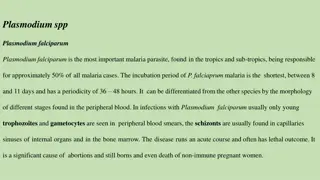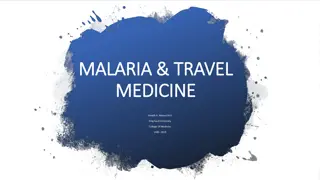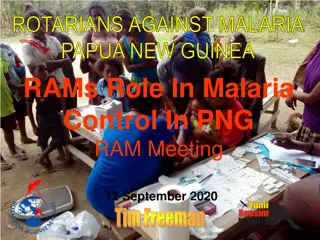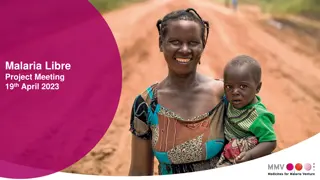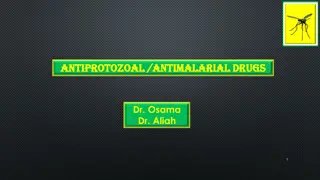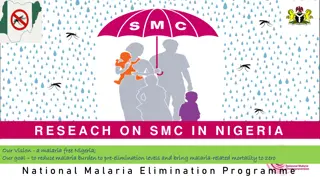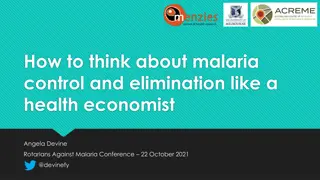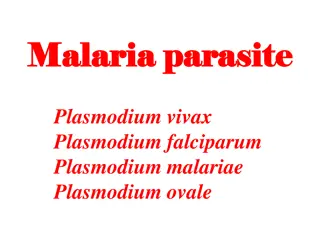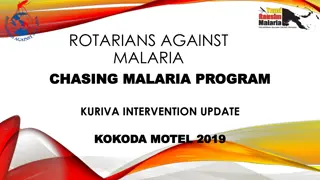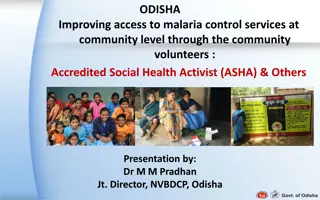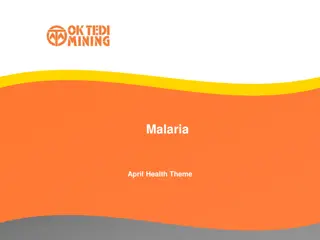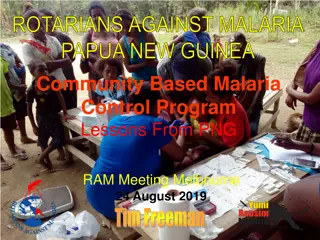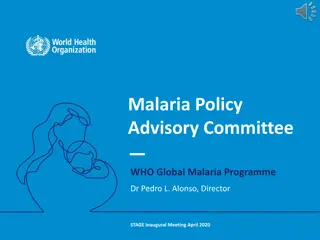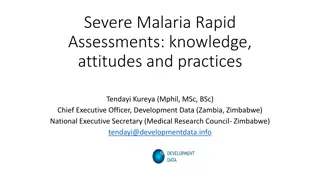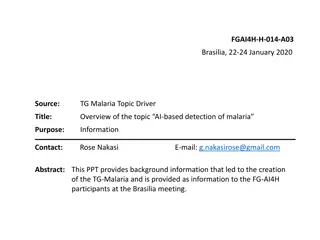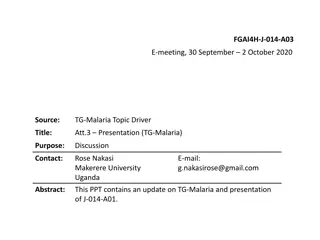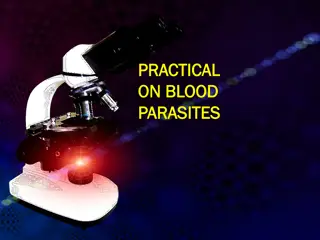Malaria Behavior for Effective SBC Interventions
Malaria Behavior Survey (MBS) by Johns Hopkins University aims to inform strategies by identifying factors related to mosquito net use, IPTp adoption, and fever treatment in children. The survey covers multiple countries and employs a robust methodology with data collected using ideation model-informed questionnaires.
Download Presentation

Please find below an Image/Link to download the presentation.
The content on the website is provided AS IS for your information and personal use only. It may not be sold, licensed, or shared on other websites without obtaining consent from the author.If you encounter any issues during the download, it is possible that the publisher has removed the file from their server.
You are allowed to download the files provided on this website for personal or commercial use, subject to the condition that they are used lawfully. All files are the property of their respective owners.
The content on the website is provided AS IS for your information and personal use only. It may not be sold, licensed, or shared on other websites without obtaining consent from the author.
E N D
Presentation Transcript
Malaria Behavior Survey (MBS) Malaria Behavior Survey (MBS) Johns Hopkins University Center for Communication Programs Breakthrough ACTION
Introduction Introduction Malaria elimination relies heavily on the adoption of appropriate behaviors. Effective SBC interventions need to incorporate determinants of malaria-related behaviors. Data on the determinants of malaria-related behaviors are lacking in most settings.
MBS Objectives MBS Objectives Inform SBC strategies and programs by: 1. Identifying and understanding the demographic, psychosocial and contextual factors associated with: The use and maintenance of mosquito nets; Adoption of the Intermittent Approach to Preventive Treatment of Malaria During Pregnancy (IPTp); Prompt and appropriate treatment of fever in children. SMC and IRS modules are also available 2. Assessing exposure to malaria related SBC
MBS countries to date MBS countries to date Completed: C te d Ivoire: pilot Sierra Leone Cameroon In process: Malawi Tanzania Democratic Republic of Congo 4
Methodology: Sampling strategy Methodology: Sampling strategy Selection of clusters o Using probability proportionate to size Selection of households randomly within clusters Selection of Participants o In each household, interview all eligible women of reproductive age; o In a third of households, interview one eligible man (spouse or partner of one of the eligible women).
Methodology Methodology: Data Collection Tools : Data Collection Tools Three questionnaires o Household o Women's o Men s Questions were informed by the ideation model
Theoretical Foundation Theoretical Foundation Ideation Model of Social and Behavior Change Ideation Model of Social and Behavior Change
Key Ideational Concepts (1) Key Ideational Concepts (1) Perceived threat: o Perception of the severity of malaria o Perceived vulnerability to malaria (or perception of its chances of being infected by malaria); o Each of these concepts is measured by multiple statements that require respondents to indicate their level of agreement
Key Ideational Concepts (2) Key Ideational Concepts (2) Knowledge: o Causes and means of preventing malaria; o Symptoms of malaria; o Malaria testing and treatment; o Recommended solutions: intermittent prevention; treatment of malaria during pregnancy; o Recommended number of antenatal care visits.
Key Ideational Concepts (3) Key Ideational Concepts (3) Perception of self-efficacy: Confidence in the ability to take specific measures to protect health. o Take appropriate measures to protect household members against malaria Identify the symptoms of malaria; Get enough ITNs for all household members; Quickly take a feverish child to a health facility Get enough antenatal visits during pregnancy; Take the recommended doses of IPTp; Malaria treatment adherence
Key Ideational Concepts (4) Key Ideational Concepts (4) Perceived effectiveness: Evaluate belief in the effectiveness of a recommended solution. o Perception of the effectiveness of LLINs o Diagnostic tests for malaria; o Antimalarial drugs provided in health facilities; o IPTp
Key Ideational Concepts (5) Key Ideational Concepts (5) Interpersonal communication: Discussion of a question with other people o Talk about malaria with the spouse; o Talking about malaria with friends or relatives Attitudes: Beliefs and values that individuals have about a behavior. o Preferences, use and care of ITNs, management of fever cases, malaria diagnostic test, IPTp.
Key Ideational Concepts (6) Key Ideational Concepts (6) Descriptive Norms: Perceptions of the prevalence of behavior in the immediate environment. o Use of ITNs, rapid search for care in case of fever, use of malaria diagnostic test in health facilities, prenatal visits, use of IPTp. Decision-making dynamics: Participation in decisions related to specific health issues in their household o Seeking care for a sick child, prenatal care and distribution of mosquito nets in the household.
Key Results Expected: Key Results Expected: Women s Women s Questionnaire Questionnaire Sociodemographic characteristics ITN use and care Use of health services for ANC and care-seeking for fever Ideation about: o Malaria (in general) o ITN use and care o IPTp and ANC visits o Care seeking for fever in children under 5 o Malaria treatment Exposure to malaria SBC activities *Optional modules on IRS and SMC may also be used
Key Results Expected: Key Results Expected: Men s Men s Questionnaire Questionnaire Sociodemographic characteristics ITN use and care Ideation about: o Malaria (in general) o ITN use and care o IPTp and ANC visits o Care seeking for fever in children under 5 o Malaria treatment Exposure to malaria SBC activities *Optional modules on IRS and SMC may also be used
Key Results Expected: Key Results Expected: Household Questionnaire Household Questionnaire List of household members Characteristics of the household Household access to health care Population ITN indicators o Use o Access and o Use given access
Partnerships and Collaborations Partnerships and Collaborations Partner Role Action NMCP Key Contributor Contribute to the design and implementation of the study. Disseminate and use results. PMI Funder Provide funding and technical guidance. Use results for MOP and program design. Local Research Firm (TBD) Implementer Hired (by Breakthrough ACTION) for data collection. Breakthrough ACTION Explore opportunities for capacity strengthening where possible NMCP SBC TWG Local Research Firm Coordinator In charge of designing and implementing the study. Disseminate and use results.
MBS Advisory Group MBS Advisory Group Members NMCP PMI Breakthrough ACTION Terms of reference Keep MBS activities moving from the planning phase through to final dissemination Advise on IRB, local permissions and geography Make key decisions Overcome bottlenecks Organize dissemination 18
Timing of the survey Timing of the survey Ideal timing is near the end of rainy season, or shortly afterwards 19
MBS Steps MBS Steps Dialogue and planning with NMCP and PMI Sampling scheme and zoning, geographic scope and timeline Secure necessary funding once geography and sampling is finalized Adjust and finalize data collection tools Local Ethics Committee submission JHU Ethics Committee submission Selection of local research firm Obtain local permissions Train data collectors Implement and supervise field work Data analysis Participatory results interpretation workshop Report writing and dissemination o o 20
Questions? Questions?
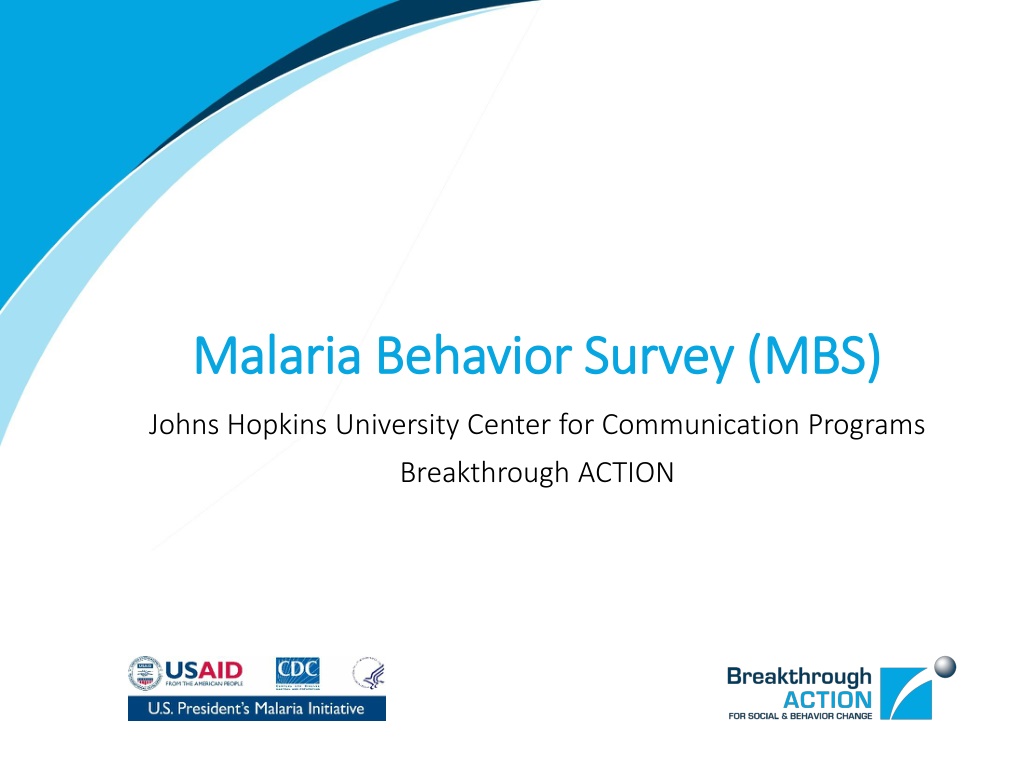
 undefined
undefined











